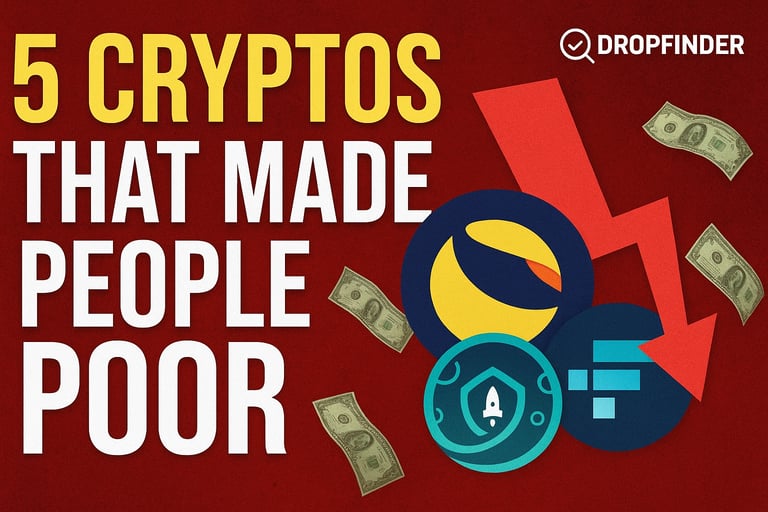5 Cryptocurrencies That Made People Poor – The Dark Side of Hype and Greed
Not every crypto is a golden ticket to wealth. Some coins have destroyed fortunes, wiping out life savings overnight. In this article, DropFinder explores the top 5 cryptocurrencies that made people poor — exposing how greed, false promises, and market manipulation turned dreams of riches into nightmares.
LATEST AIRDROPCRYPTO NEWS
10/12/20255 min read
Introduction: The Harsh Reality of Crypto Losses
Cryptocurrency is often seen as the path to instant riches — stories of early Bitcoin and Ethereum investors becoming millionaires in their sleep have fueled dreams worldwide. But there’s another, darker side of crypto that rarely makes headlines: the countless people who lost everything chasing the next “moonshot.”
Every bull run brings waves of new investors hoping to find “the next Bitcoin.” Scammers, developers with bad intentions, and overhyped projects flood the market, preying on greed and FOMO (fear of missing out). When the music stops, those left holding the bag face devastating losses.
In this blog, DropFinder dives deep into five cryptocurrencies that made thousands — even millions — of people poor. These aren’t just coins; they’re cautionary tales of hype, deception, and misplaced trust.
1. Terra (LUNA) – The $60 Billion Collapse
The Hype:
Terra (LUNA) was once seen as the future of decentralized finance. With its algorithmic stablecoin, UST, it promised stability in a volatile crypto world. Investors and influencers hailed it as a “game-changer,” and by early 2022, LUNA had rocketed from under $1 to over $115.
The Crash:
In May 2022, the impossible happened — UST, designed to stay at $1, lost its peg. Once that peg broke, panic erupted. LUNA’s price collapsed from $115 to fractions of a cent in just a few days. More than $60 billion vanished almost overnight.
People who had invested their savings — even entire life funds — were left with nothing. Online forums were flooded with stories of heartbreak, depression, and even tragedy.
Lesson Learned:
Never trust “guaranteed” returns or algorithmic stablecoins without collateral. If it sounds too good to be true, it usually is.
2. FTX Token (FTT) – When a Giant Fell
The Hype:
FTX wasn’t just another exchange; it was the exchange. Backed by celebrities, sports teams, and big investors, FTX looked like the safest place to trade crypto. Its native token, FTT, was promoted as a key part of the ecosystem — offering discounts, rewards, and staking incentives.
The Crash:
In November 2022, FTX collapsed spectacularly when it was revealed that billions in user funds had been misused by the company’s leadership. FTT, once worth over $80, dropped to near zero.
Thousands of investors, including experienced traders, lost everything. The illusion of safety shattered overnight.
Lesson Learned:
Even the biggest names can deceive. Always self-custody your crypto — “Not your keys, not your coins.”
3. BitConnect – The King of Crypto Scams
The Hype:
BitConnect launched in 2016 with promises of “guaranteed daily profits.” Its slick marketing and referral program attracted thousands of investors globally. The platform claimed its “trading bot” could deliver consistent returns of 1% daily.
That sounds small, but compounded daily, it meant exponential profits — an irresistible pitch for beginners.
The Crash:
By 2018, regulators began investigating. It turned out BitConnect was nothing more than a classic Ponzi scheme. When the founders vanished, the coin’s price plummeted from $400 to less than $1.
People lost billions collectively. It remains one of the biggest crypto scams in history.
Lesson Learned:
Never invest in something you don’t understand — especially if it promises fixed or guaranteed returns. Real markets don’t work like that.
4. SafeMoon – From Meme Coin to Nightmare
The Hype:
Launched in 2021 during the meme coin craze, SafeMoon promised “to the moon” gains. Its tokenomics — rewarding holders with a share of transaction fees and punishing sellers — created immense buzz on TikTok and Reddit. Influencers and celebrities jumped aboard, fueling the hype.
The Crash:
After peaking in April 2021, SafeMoon’s price dropped more than 95% in just months. Many early investors made money — but most retail traders, who bought during the hype, suffered huge losses.
Investigations later suggested that key developers had misused project funds.
Lesson Learned:
Meme coins are pure speculation. They can make you rich in hours — or destroy you overnight. Always treat them as high-risk, short-term plays.
5. Squid Game Token (SQUID) – The Rug Pull Everyone Saw Coming
The Hype:
Inspired by Netflix’s “Squid Game,” the SQUID token launched in late 2021 and quickly went viral. The creators claimed it would be part of a play-to-earn game based on the show’s concept. The coin skyrocketed from $0.01 to over $2,800 in just days.
The Crash:
Then, the developers vanished. Liquidity was pulled — a classic “rug pull.” Investors discovered they couldn’t even sell their tokens. Within minutes, SQUID fell to $0.0007.
Thousands lost money. It was one of the most blatant scams in crypto history — but the hype was so strong that few cared to verify its legitimacy before investing.
Lesson Learned:
Always verify the team, whitepaper, and liquidity before investing in new tokens. Viral popularity doesn’t mean authenticity.
The Common Thread – Greed, FOMO, and Blind Trust
Across all these collapses, the pattern is clear: greed and lack of due diligence. People chased quick profits without understanding what they were buying. Many ignored red flags because of influencer hype or the fear of missing out.
Crypto is a powerful technology — but it’s also an unregulated playground filled with risks. Most losses occur when investors treat it like a casino instead of a market that requires knowledge, patience, and risk management.
How to Protect Yourself from Losing Money in Crypto
1. Research Every Project
Don’t just buy a coin because it’s trending. Study its whitepaper, team, use case, and market capitalization. Use trusted sources like DropFinder to check real community data, tokenomics, and legitimacy.
2. Avoid “Too Good to Be True” Promises
No legitimate project offers guaranteed profits or daily returns. Be skeptical of anyone who does.
3. Store Safely
Use hardware wallets or trusted custodial platforms. Avoid leaving large amounts on exchanges.
4. Diversify Wisely
Don’t go all-in on one token. Spread your investments across assets with real value, like Bitcoin or Ethereum, along with smaller, well-researched altcoins.
5. Stay Updated
Follow trusted platforms like DropFinder for verified crypto insights, airdrops, and genuine updates. Knowledge is the best protection in the crypto space.
Emotional Side: How Losing in Crypto Hurts More Than Just Money
Losing money in crypto doesn’t just destroy finances — it can also harm mental health. Many investors faced severe depression and stress after crashes like Terra or FTX. Some even took extreme steps due to financial pressure.
It’s important to remember: Crypto is a tool, not a lottery.
You can always rebuild wealth, but not if you lose yourself chasing it.
If you’ve suffered losses, step back, analyze what went wrong, and learn from it. The most successful traders in history — from traditional markets to crypto — have all faced heavy losses before mastering emotional control and strategy.
The Flip Side – The Opportunity Still Exists
While these failures are painful lessons, crypto still holds potential. Bitcoin, Ethereum, Solana, and other legitimate networks continue to innovate and offer real-world value. For every scam, there are genuine projects building the decentralized future.
The key is research, discipline, and patience.
Instead of chasing hype, focus on technology, adoption, and fundamentals. Study how blockchains work. Learn to read charts and understand tokenomics. Tools like DropFinder can help you find authentic airdrops and early projects with transparency — not hidden traps.
Final Thoughts – Crypto Doesn’t Make People Poor, Choices Do
Crypto itself isn’t evil — human behavior is. Greed, impatience, and lack of due diligence have cost investors billions.
The next time a coin claims it will make you rich overnight, remember the millions who believed the same — and lost everything.
Use this article as a reminder: success in crypto is about education, timing, and risk control, not luck.
As DropFinder always emphasizes — “Research before you invest, not after you lose.”
Reference:
This educational article was inspired by DropFinder, your trusted crypto platform for airdrop alerts, real project insights, and scam-free opportunities. Visit DropFinder.info to stay informed and safe while exploring the crypto world.




